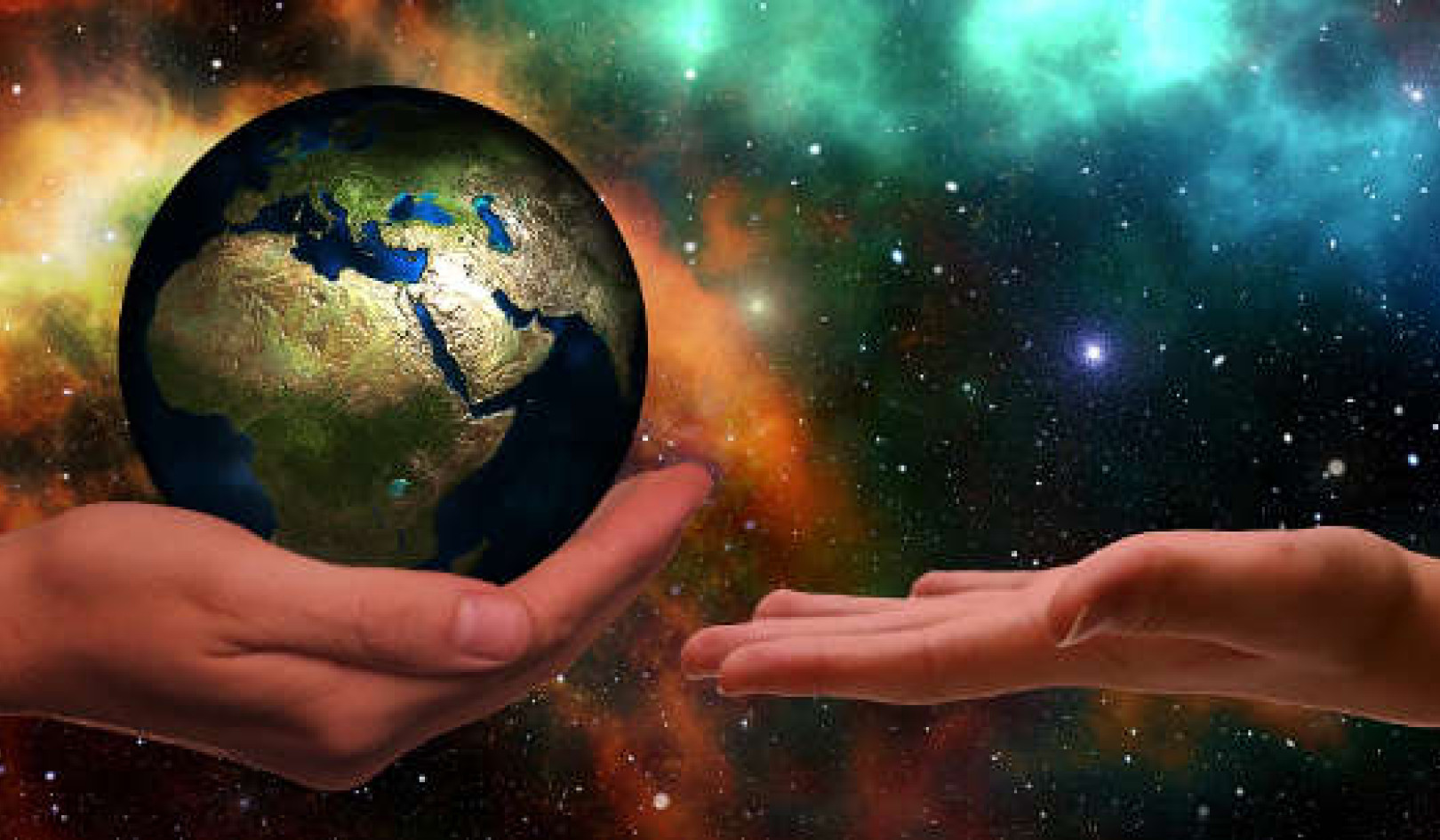Bridging the Gap with Jupiter and Saturn
This is generally true also of Jupiter and Saturn, the two planets that help to bridge the gap between the outer planets and the inner planets (Sun, Moon, Mercury, Venus, and Mars). The inner planets relate us most obviously to our immediate environments and with the daily fluctuations, situations, and abiding interests of humanity. Their progressions and transits frequently coincide with marriages, births, love affairs, and other temporal events.
Astrologers frequently refer to Jupiter and Saturn as the "social planets", since they are concerned with matters beyond the individual, but not yet transcendent. They are especially active in matters of social order, finance, and government, and help to unite individuals and nations. Jupiter and Saturn represent cycles of expansion and contraction, respectively. In terms of nations, these cycles embrace inflation and recession, and at the individual level they signify periods of optimism or limitation. At the height of the Piscean Age, when religion and government were identified with each other, Jupiter and Saturn shared astrological rulership of matters both spiritual and temporal, reflecting the existing limits of human understanding.
Jupiter and Saturn do act as bridges between the two realms (temporal and spiritual) in the sense that the group, represented by Jupiter and Saturn, must eventually reconnect consciously with its soul, represented (according to our present understanding) by the outer planets. Increasingly, however, the interface between inner and outer dimensions will be associated with Chiron, whose orbit links the Saturnian world of form with the transpersonal realms of Uranus and beyond.
Because the outer planets move ponderously, setting the tone for long periods of time, when they are aspected by the faster moving planets they tend to be associated with important events. The overall character or "energy signature" of these events can be ascertained by understanding the house and sign positions of the planets or points involved and relating these indications back to their natal potentials.
For example, a person with Jupiter in aspect to Pluto in the birth chart will always have profound mystical and spiritual tendencies and might be inclined toward some of the more arcane expressions of these, such as ceremonial magic. He or she will never be content with surface solutions and will want to go to the heart of life itself for answers. If Jupiter is in the 4th house of the birth chart and Pluto is in the 1st, there will be repercussions in the areas of personal security and psychological foundations (4th house) and in terms of crises about personal identity (1st house). If Jupiter is in Taurus and Pluto is in Leo, there will always be a concern with matters of personal security and safety as they impact on chosen forms of self-expression and leadership, and vice versa. When either Jupiter or Pluto are contacted by a progressed or transiting planet, this natal potential will be activated, particularly if the contacting planet is sensitively placed in the birth chart. This activation will be modified by the nature of the contacting planet. If the contacting planet should happen to be Mercury, the person might decide to go back to school or to take a correspondence course in a Jupiterian or Pluto-related field in order to broaden his or her horizons, expand the personal identity (1st house and Leo), and secure a more solid basis for his or her personal philosophy (4th house and Taurus). If the contacting planet is Venus, a deep love affair might result, or there might be a money crisis of some sort.
Outer Planets as Trendsetters
Since the outer planets never move more than a few degrees in a person's secondary progressed chart, they are critical as overall trendsetters. Of course, they move quite a bit in a chart directed by solar arc. By far, the most significant movements of the outer planets, however, occur with their transits. Their effects tend to be consonant with their "condition" in the birth chart, and they are very noticeable.
Because the outer planets are esoteric significators of spirit, whose purpose is to link our souls with the group soul of humanity, their transits always present us with opportunities for transformation. Transits of the outer planets are associated with spiritual breakthroughs linked to the areas of life activated by the house and sign they are transiting in a natal chart.
For many astrologers (myself included), the transiting positions of the outer planets and Saturn are the most important factors to consider in updating natal charts. Saturn crystallizes and provides structures for experience; Uranus breaks up existing structures so that we do not become fossilized in habit. Galvanizing whatever he touches, Uranus stirs things up. He rocks the boat. We cannot be complacent for long in any area affected by Uranus.
Whereas Uranus shatters outworn thought forms, Neptune dissolves them. When he transits an area of the birth chart, those aspects of life will be up for review in a very subtle kind of way, and we will be apt to experience confusion and mental fogs. Neptune is particularly identified with the astral plane, the storehouse of images, and puts us in touch with that part of ourselves so that we can grow in self-knowledge and discrimination.
Pluto: Change or be Changed
Pluto transiting through the natal chart utterly and irrevocably transforms any area of life he touches. Existing conditions will be reformed, and that is all there is to it. There are no halfway measures with Pluto. His message is to change, or be changed. Yet his lessons are so profound that they cannot be learned in any other way. Time and again after Pluto has finished transiting a certain house in someone's birth chart, that person will speak of the transit almost nostalgically, even if the experience was traumatic. Through this transit, one is enabled to access such deeply significant aspects of him/herself that the result is awe of Pluto's wisdom and power, and an appreciation of his energy that transcends considerations of personal comfort. This brings us to the next point, which is the part we play in our own process of change.
Four Options for Change
We have basically four options when it comes to change -- resistance, acceptance, resignation, and affirmation. Whichever option we choose becomes critical in the matter of the outer planets, whose lessons are vital if we are to become all that spirit intends for us to be.
Resistance is ultimately self-defeating, yet it is natural in the context of our first faltering experiences with significant transits and progressions to difficult natal planetary placements. Indeed, resistance is a valuable tool for growth in the first part of life, when we must learn about limits and boundaries.
As we grow, we learn that the degree of pain experienced through outer-planet transits is directly proportional to the amount of resistance we generate. All outerplanet transits go smoother when we consciously adopt a spiritual attitude toward their energies. It is when we maintain our reliance on material attachments that we have the most trouble.
Eventually, with wisdom, we come to see that resistance to life's processes is death in life, and we are prompted to search for the why's and wherefore's of existence. The prompting comes, paradoxically, through the same agencies that "brought" us our problems. It is in this way that we as individuals move into the collective stream of human experience, enriching that body of knowledge with our own hard-won learning. We can then move into the sphere of acceptance, which opens us up to further growth.
Resignation is a negative form of acceptance, and it often wears the face of bitterness following a hard experience. Persisted in, resignation represents a brittle rejection of the fullness of life and its shades of gray, its peaks and valleys.
The state for which we were born, and toward which we are constantly evolving, is affirmation. When our attitude toward change is consistently characterized by this vibrant response to experience -- all experience -- we are well on the way toward mastery. It may be the work of many lifetimes, but by orienting toward the affirmative state in our desires and in our minds, we will magnetize ourselves to attract and eventually manifest it.
Astrological transits and progressions reflect overall forward momentum and show us how we grow. The coordinated movements of inner, social, and outer planets coincide with periods of learning, integration, and renewal in our lives. There is ever within us that which strives toward the light. The light is filtered and focused through planets and signs in their seasons, as all participate in the joys and challenges of evolutionary change.
Resources:
-
Alice Bailey, Esoteric Astrology, New York: Lucis Publishing, 1985.
-
Alan Leo, Esoteric Astrology, Rochester, NY: Destiny Books, 1983.
-
Ruth Miersa, Ray-Centered Astrology, San Diego, CA: Libra Publishers, 1986.
-
Errol Weiner, Transpersonal Astrology, Rockport: Element, 1991.
-
Kees Zoeteman, Gaiasophy, Hudson: Lindisfarne Press, 1991.
©1996 Bonnie Wells - all rights reserved
Recommended book:

"Esoteric Astrology"
by Alan Leo.
Info/Order this book
About The Author 
Bonnie Wells has practiced astrology since 1970. She specializes in esoteric astrology and is a student of metaphysics, in particular the Alice A. Bailey material.
























